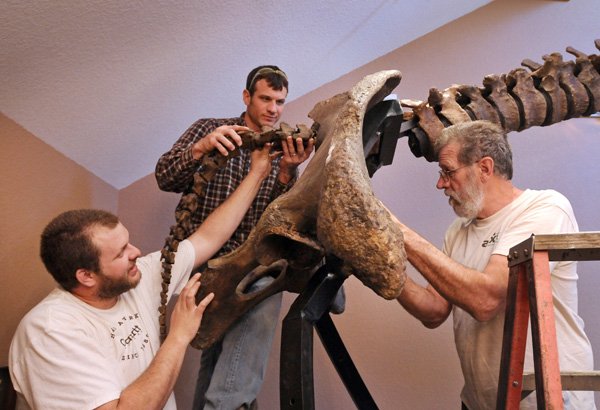BENTONVILLE -- Museum of Native American History visitors now will be greeted by a giant mammoth.
Well, just its bones.
At A Glance
Mammoth
Visitors can see the mammoth skeleton at the Museum of Native American History, 202 S.W. O St. Museum hours are from 9 a.m. to 5 p.m. Monday through Saturday. Admission is free.
Source: Museum of Native American History
The 12-foot-tall, 17-foot-long skeleton was pieced together in the museum's entryway Tuesday.
"That sets the pace," said Charlotte Buchanan-Yale with the museum's public relations and marketing. "When you see it, you know you're in for a grand ride."
The skeletal creature needs a name, and the museum is taking suggestions, Buchanan-Yale said.
"We have been looking for quite a while trying to acquire a mammoth (skeleton)," said David Bogle, owner and director.
The museum got it from GeoDecor, a company that specializes in fossils, minerals and meteorites. It's based in Tucson, Ariz.
The skeleton is about 90 percent original bone with some restored bones, according to the company's website. The skeleton is a composite, meaning it "represents the bones of more than one animal." The tusks are a matching pair and are original fossil ivory.
The specimen fits into the story the museum tells of a 16,000-year history of the earliest people on the continent, Bogle said.
The paleo period was from around 12,000 B.C. to 8,000 B.C. and is the oldest period of American history, according to the museum's website.
Paleolithic Indians hunted mammoths with spears and both man-made and natural traps, such as canyons or sandy river bottoms, said Matt Rowe, curator.
"Whenever they killed one, it was a great source of food for a long time so it was really important," he said.
Indians also would use the hides for clothing and blankets, the ivory to carve and make tools, and the bones for the framework of their dwellings, Rowe said.
Bogle and Rowe said the skeleton will draw more people to the museum. Neither knew where the next closest one is located.
"I think people will learn a lot from it and appreciate how monstrous this beast was and what a chore it was for paleo Indians to hunt and kill this," Bogle said.
Rowe reiterated how it will allow visitors to get a sense of its size.
"You can tell someone that it's 12 foot tall, but they don't understand that until they get right there and are actually able to see it," he said.
A cast of a mastodon skull was removed from the entrance to make room for the mammoth skeleton. It was on loan from the University of Arkansas, Rowe said. It was returned Wednesday.
"We enjoyed it while it was here," he said.
The easiest way to tell the difference between a mastodon and mammoth is the teeth, Bogle said walking over to the mastodon skull.
Its teeth were similar to those of human teeth, just much larger. The mammoth's teeth had more of a flat surface with ridges and looked like the bottom of a shoe.
The mammoth skeleton will be a permanent exhibit, Bogle said.
Bogle wouldn't say how much the historic artifact cost.
NW News on 03/21/2014

